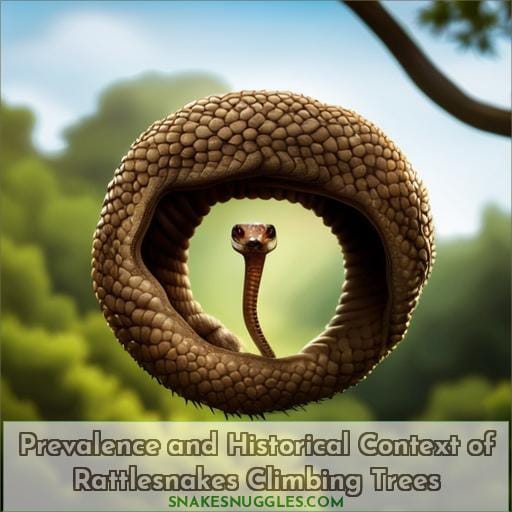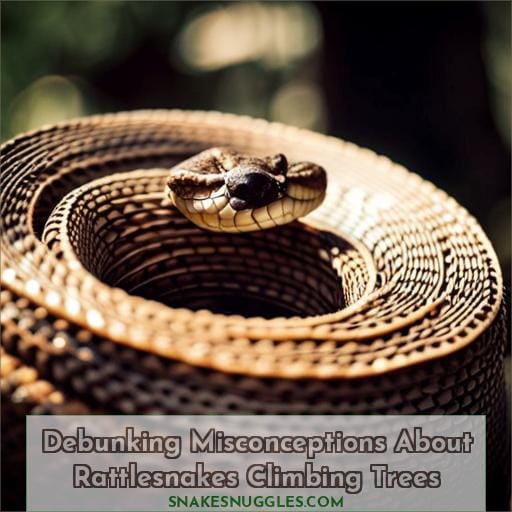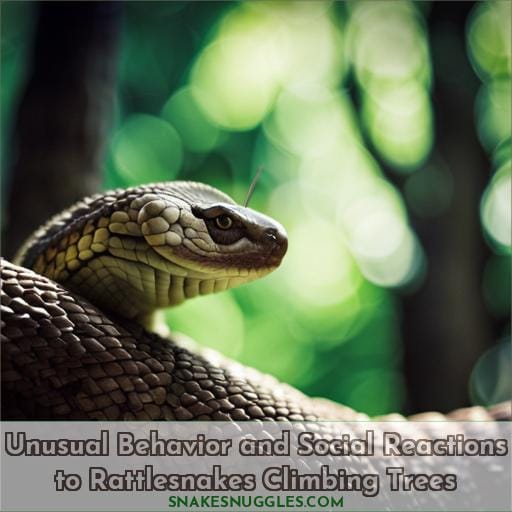This site is supported by our readers. We may earn a commission, at no cost to you, if you purchase through links.
 So you’ve heard the buzz about rattlesnakes climbing trees? It’s true – in some cases, these venomous snakes have been spotted sunbathing and even hunting birds at great heights. But how common is it for a rattlesnake to climb a tree? While their surprising behavior has caused alarm on social media, understanding the prevalence of this activity within different species can help us better appreciate why they do it.
So you’ve heard the buzz about rattlesnakes climbing trees? It’s true – in some cases, these venomous snakes have been spotted sunbathing and even hunting birds at great heights. But how common is it for a rattlesnake to climb a tree? While their surprising behavior has caused alarm on social media, understanding the prevalence of this activity within different species can help us better appreciate why they do it.
Table Of Contents
- Key Takeaways
- Rattlesnakes Climbing Trees: a Surprising Behavior
- Prevalence and Historical Context of Rattlesnakes Climbing Trees
- Possible Reasons for Rattlesnakes Climbing Trees
- Climbing Mechanics and Comparison to Other Climbing Snakes
- Debunking Misconceptions About Rattlesnakes Climbing Trees
- Personal Observations and Experiences With Rattlesnakes Climbing Trees
- Validity and Importance of Rattlesnakes Climbing Trees
- Unusual Behavior and Social Reactions to Rattlesnakes Climbing Trees
- Frequently Asked Questions (FAQs)
- Are all rattlesnakes capable of climbing trees?
- Is there a difference between rattlesnakes and other snakes when it comes to tree climbing?
- What is the most common reason for a rattlesnake to climb a tree?
- How often do rattlesnakes climb trees?
- Are there any safety considerations to be aware of when encountering rattlesnakes in trees?
- Conclusion
Key Takeaways
- Rattlesnakes in the American Southwest exhibit tree-climbing behavior for sunbathing, hunting, and escaping predators.
- Western diamondback rattlesnakes in Arizona and timber rattlers in Texas are known to climb trees.
- Climbing is used for temperature regulation, accessing prey, and enhancing safety from predators.
- Rattlesnakes’ climbing skills are linked to their natural adaptation to diverse climates and habitats.
Rattlesnakes Climbing Trees: a Surprising Behavior
You may have heard about recent sightings of sunbathing rattlesnakes climbing trees, and even a remarkable encounter between a snake and a sparrow’s nest. Social media has been abuzz with the news of a western diamondback rattlesnake spotted up a tree in Arizona.
So why are these snakes taking to the treetops? Let us explore this surprising behavior further.
Sunbathing Rattlesnakes Spotted Climbing Trees
You may be surprised to know that rattlesnakes have been spotted sunbathing in trees, a behavior that captivated observers across the southwestern US. Evidence suggests they climb for hunting birds and mammals or escaping predators, using lateral undulation and concertina mode techniques.
Western diamondback rattlesnake sightings on social media generated buzz, while timber rattlers are known to ascend up to 50 feet high in Texas.
Snake Vs. Sparrow Nest Encounter
Witness one of nature’s most unexpected encounters: a rattlesnake and a sparrow protecting its nest. Fleeing from danger, the snake skulks up through the branches with ease while eluding predators. However, some species are more adept than others. Golden lanceheads and rough green snakes have been seen twig-walking in South America.
Brown tree snakes are even considered tree specialists! But despite their climbing skillset, they still find themselves spooked by birds defending their nests.
Social Media Buzz Around a Rattlesnake in an Arizona Tree
Surprise and unease spread quickly when a venomous rattlesnake was spotted high in an Arizona tree, prompting social media users to share their astonishment. Climbing mechanics differed between species; rat and corn snakes were more proficient climbers due to body shape than the timber rattlers.
Dismissing public misconceptions about water moccasins’ supposed tree-jumping behavior, observations of black-tailed rattlesnakes ascending trees for hunting purposes proved valid. Social reactions expressed surprise at this unusual but genuine phenomenon while emphasizing the importance of accurate information dissemination before commenting on such matters.
Prevalence and Historical Context of Rattlesnakes Climbing Trees
You may have heard of recent sightings of rattlesnakes climbing trees, but this behavior is not new. Tree-climbing has been observed for multiple species in the American Southwest and provides a way to regulate body temperature during hot desert summers.
Previous Sightings of Climbing Rattlesnakes
Recent reports of these scaly reptiles scaling tall trees have been popping up like popcorn. Rattlesnakes, from elapids to colubrids, are climbing for hunting prey or temperature regulation or even escaping predators.
A mesquite tree in New Mexico was recently spotted with a rattlesnake atop it, and people were surprised! Specialized fences around homes also prevent them from accessing prey while climbing trees. Unusual behavior such as this sheds light on the adaptability of snake species and emphasizes the importance of accurate information dissemination before commenting on social media reactions.
Multiple Rattlesnake Species in Trees in the American Southwest
You may be amazed to hear that multiple rattlesnake species have been seen up in trees across the American Southwest. Rattlesnakes are known to adapt to different climates, including arid ones, and their habitat selection is impacted by factors like predator avoidance or prey accessibility.
Species such as Timber Rattlers have even been observed climbing up more than 50 feet off the ground! Natural observation has revealed how some east coast snake species also exhibit similar climbing behavior.
As scientists continue studying these creatures’ ecological roles, it’s becoming clearer that understanding their behavior is key for coexistence with humans in society.
Tree Climbing Aids in Temperature Regulation
By climbing trees, rattlesnakes can better regulate their body temperature in the desert heat while seeking shelter from predators and preying on animals. During hot monsoon seasons, non-venomous climbers like paradise flying snakes are often seen scaling tall heights for cooler temperatures.
Rattlesnakes use a technique known as ‘lateral undulation’ to climb objects of various shapes and sizes.
Possible Reasons for Rattlesnakes Climbing Trees
Rattlesnakes are surprisingly proficient climbers and have even been spotted up to 50 feet high in trees. They climb for multiple reasons, including hunting birds and mammals, as well as regulating their body temperature during the hot desert summers.
Although rarely posing a threat to humans, these unusual climbing behaviors continue to be documented throughout the American Southwest.
Hunting Birds and Mammals
Rattlesnakes may climb trees to hunt birds and small mammals, a behavior that is observed in multiple species of rattlers throughout the American Southwest. Hunting methods vary by species. For example, the speckled rattlesnake relies on its climbing technique, while the banded rock rattlesnake prefers snake hunting from below.
Climbing techniques include lateral undulation and concertina mode, which aid snakes in accessing prey. These techniques also help them find arboreal basking perches, which are important for climate regulation during desert summers.
Snake characteristics, such as body shape, can impact success rates when it comes to tree-climbing.
Unlikely Threat to Humans
Although rattlesnakes are venomous, it’s unlikely they’ll fall from trees and pose a threat to you. These snakes use climbing as an environmental adaptation for predator avoidance or locating hiding places for prey like birds and small mammals.
Rattlesnakes can climb various tree types using two methods: lateral undulation or concertina mode. They may also seek out sun-exposed branches due to their temperature regulation needs in the desert habitat.
Common misconceptions about snake behavior should not be taken at face value; cottonmouths rarely jump from trees while timber rattlers can scale heights of up to 50 feet with relative ease! Although these behaviors may look alarming, there is no need to fear these arboreal reptiles who cleverly manipulate their environment with specialized diet and climbing techniques for survival benefits.
Timber Rattlesnakes as Proficient Climbers
You may be surprised to discover that Timber Rattlesnakes are actually quite adept climbers, able to ascend trees up to 50 feet high in Texas. They utilize lateral undulation and concertina mode for climbing walls or fences.
Their venomous abilities allow them to tree bask, which helps regulate temperature during desert summers. While they can climb rough surfaces with ease, other snake species such as rat snakes and corn snakes have better anatomy for navigating obstacles due to the shape of their body and limbs.
Climbing Mechanics and Comparison to Other Climbing Snakes
You may be surprised to learn that rattlesnakes can climb trees! This unusual behavior is facilitated by the use of two techniques: lateral undulation and concertina mode. The timber rattler, though less proficient in tree climbing due to its body structure, can still ascend up to 50 feet high in Texas.
In contrast, rat and corn snakes excel at climbing thanks to their more suitable body shape. Specialized fences are being developed specifically for preventing a snake’s ability to climb certain surfaces.
Lateral Undulation and Concertina Mode Techniques
You’ll find rattlesnakes slithering up trees using two main techniques: lateral undulation and concertina mode. The regulatory advantages gained by climbing make it a normal behavior for some species, like the timber rattlesnake, to escape predators or migrate along a pathway.
However, their venomous nature makes them less adept than other snake species due to body morphology; specialized fencing can be used as an effective deterrent for tree-climbing snakes like the tiger rattlesnake.
Timber Rattlers as Less Proficient Climbers
Though timber rattlesnakes may sometimes climb trees, they are not as proficient at it compared to other snake species. Arboreal basking allows them access to prey and a chance for temperature regulation during desert summers, but specialized fences have been designed to prevent such climbing activities.
Timber rattlers often get falsely identified with water moccasins due to similar characteristics. However, an easy Google search can quickly show the differences between those two snakes. So, while these creatures may be seen in trees more than expected, their lack of adeptness means they should never pose a real threat when encountered by humans outside of ground level navigation.
Rat and Corn Snakes as Excellent Climbers
Experience the remarkable agility and strength of rat and corn snakes as they effortlessly ascend trees! With specialized body shapes, these species are superb climbers. But for some rattlesnakes, arboreal basking is a key temperature regulation strategy – making their climbing mechanics essential in the American Southwest.
Prey hunting is also likely to be a factor; timber rattlers have even been seen up to fifty feet high in Texas.
Specialized Fences to Prevent Rattlesnake Climbing
To protect against the unusual behavior of rattlesnakes climbing trees, a specialized fence has been designed – but will it be effective? Heat sensing may detect movement and alert humans, while certain tree species have fewer branches for the snakes to use as climbing aids.
However, claims of jumping are debunked due to their lack of proficiency compared to other snake species. Venomous snakes still pose a threat despite this new technology; caution is advised when encountering these arboreal creatures in nature.
Debunking Misconceptions About Rattlesnakes Climbing Trees
You may have heard of cottonmouths, or water moccasins, being able to climb trees. However, this is not accurate; while these snakes can bask in the branches on occasion, they are nowhere near as proficient climbers as rattlesnakes.
Additionally, there’s no evidence that suggests water moccasins jump from tree to tree despite the popular myth surrounding them. Rattlesnakes’ climbing abilities are more comparable with rat and corn snakes due to their body shape and size than other species of snake, which enables them to access prey higher up in a tree or escape predators quickly if needed.
Cottonmouth Snakes and Their Climbing Abilities
You may be surprised to hear that cottonmouth snakes, despite their reputation for being dangerous predators, are not as adept at climbing trees as other snake species. In fact, while they can take refuge in tree perches due to the increased flight risk posed by terrestrial predators and climate adaptation needs from desert summers, they rely heavily on aquatic food sources and use venomous threats when necessary.
While these serpents have been known to climb rough surfaces like timber rattlesnakes do, it is a much less common behavior compared with rat or corn snakes who share similar body shapes which allow them easier access up trees, even 50 feet high!
Disproving the Myth of Tree-jumping Water Moccasins
Despite popular belief, water moccasins don’t actually jump from trees – the misconception is easily disproven. Mythical perceptions of this behavior can be attributed to conflicting information and unfamiliarity with rattlesnake climbing abilities.
Tree-jumping prevents access to prey, yet does not provide any basking benefits like temperature regulation or safety that tree-climbing offers other snake species.
Rattlesnakes’ Climbing Skills Compared to Other Snake Species
Comparing rattlesnakes to other snake species, timber rattlers can climb up to an impressive 50 feet high! Rattlesnakes’ prey-accessing and temperature-regulating behaviors are aided by the arboreal basking perch.
Specialized fences prevent climbing in some areas, while their mechanics – lateral undulation and concertina mode – allow for a more proficient ascent than water moccasins or rat snakes. Timber rattlers may be less adept due to body structure; however, they do ascend trees at times, making them an interesting species comparison with their slithering counterparts.
Personal Observations and Experiences With Rattlesnakes Climbing Trees
You may be surprised to learn that rattlesnakes can climb trees. Personal accounts and videos of different species have been circulating on social media, showing Western Diamondback Rattlesnakes up to 50 feet high in Texas and Black-tailed Rattlesnakes ascending for hunting purposes.
These observations are legitimate and attest to the adaptability of snakes in a variety of situations – escaping predators, accessing prey, or regulating their temperature.
Encounters With Different Rattlesnake Species in Trees
Observing rattlesnakes in trees can be a memorable experience, with multiple species spotted basking and hunting from the branches. Western diamondback rattlesnakes are seen up to 50 feet high in Texas, while others may be found foraging or hibernating there.
Courtship behavior has been observed between snakes on elevated perches, as well as predator-prey interactions involving birds protecting their nests from climbing predators. Some species of rattlesnakes use camouflage to blend into the tree bark and foliage – a critical adaptation for successful hunts! With careful observation, one can witness an unexpected yet fascinating natural phenomenon rarely discussed before 2020.
Reasons for Climbing: Escape, Hunting, Etc
You may be surprised to learn that rattlesnakes often climb trees for a variety of reasons, such as hunting prey or escaping predators – making it truly a case of ‘the early bird catches the worm’. Rattlesnakes utilize two main climbing techniques – lateral undulation and concertina mode.
Tree selection is important; they use rough bark for grip. Some species are better climbers than others due to their body shape and structure. Timber rattlers can reach up to 50 feet high in Texas! Predation strategies vary according to habitat, but thermoregulation is also an important factor during desert summers.
Validity of Observed Snakes in Trees
The validity of snakes climbing trees has been affirmed through personal encounters with various rattlesnake species, generating surprise and unease in social media reactions. Photoshopped evidence or snake anatomy doesn’t change the fact that multiple species have been spotted up to fifty feet high.
Timber Rattlers may be less proficient climbers due to their body structure, but arboreal basking is a key factor aiding in temperature regulation during desert summers for them and other snake species alike.
This unusual behavior highlights not only the adaptability of rattlesnakes but also the importance of accurate information dissemination when discussing such matters.
Validity and Importance of Rattlesnakes Climbing Trees
You may have heard of rattlesnakes climbing trees, and it is true. Genuine photos and personal experiences support the behavior of these snakes in trees for reasons such as prey access, safety, or temperature regulation.
It is important to consider accurate information dissemination when discussing this topic; research should be done before commenting on it.
Genuine Photos and Personal Experiences Supporting Climbing Behavior
Witnessing a rattlesnake slither up a tree can be both fascinating and alarming – it’s an eye-opening reminder of their incredible adaptability. Personal experiences, genuine photos, and social media reactions support the prevalence of this behavior.
Reasons include: hunting birds and mammals, regulating temperature; plus timber rattlers climb to heights over 50ft! Snake species vary in climbing ability — rat and corn snakes excel due to body shape — but all are photoshop-proof validities debunking water moccasin myths.
Reasons for Climbing: Prey Access, Safety, Temperature Regulation
Strategically scaling trees, rattlesnakes move up like a caterpillar on a leafy stalk. Hunting methods, temperature control, and prey access are all reasons for this surprising behavior. Tree safety is also an important factor; they often use the branches to avoid predators or find refuge from extreme temperatures in desert climates.
The Importance of Accurate Information Dissemination
It is vital to ensure that accurate information about rattlesnakes is shared, as their unexpected behaviors can surprise and even frighten those who witness them.
- Research before commenting on social media.
- Understand the complexities of snake behavior, including temperature regulation and prey access.
- Recognize potential risks from venomous snakes climbing trees.
- Respect scientific data regarding climbing mechanics by different species of snakes.
- Resist sensationalized news stories; check for accuracy first! Accurate information dissemination reduces fearmongering and helps protect humans from harm while preserving wildlife habitats in the American Southwest.
Unusual Behavior and Social Reactions to Rattlesnakes Climbing Trees
You may be surprised to learn that rattlesnakes can climb trees. Social media reactions have expressed surprise and unease when videos surfaced of a New Mexico rattlesnake in a mesquite tree, or when an Arizona Western diamondback was spotted up high in a tree.
A hiker even witnessed one atop a mesquite tree, prompting the publication of an article on August 18th by reporter Mark Price.
Surprise and Unease Expressed on Social Media
When news of rattlesnakes climbing trees spread on social media, many were surprised and uneasy. Fearful reactions arose as a variety of snake species jumped from branch to branch, generating media buzz.
Although timber rattlers are more prone to arboreal basking perches than cottonmouths or water moccasins, they’re not known for tree jumping – making the occurrence all the more unexpected! Evidence like genuine photos and personal experiences suggests their ability to access prey or escape predators by ascending into the canopy is valid; raising awareness regarding this unusual behavior in our world today.
Rattlesnake Spotted in a Tree by a Hiker
You might be surprised to hear that a hiker recently spotted a rattlesnake coiled up in the branches of a mesquite tree. The shock was shared on social media, generating coverage and awe for this unexpected behavior.
Rattlesnakes climb trees due to hunting, escaping predators, and regulating temperature. Unlike cottonmouths, which occasionally bask in trees but are less adept climbers, rattlesnakes use climbing mechanics such as lateral undulation and concertina mode to assist them with their ascent.
Despite the hiker’s shock at seeing this unusual behavior, it is an accepted part of rattlesnake lifestyle that helps them survive harsh desert conditions while still keeping humans safe from danger below!
Article Publication and Reporter
Mark Price, a reporter, published an article on August 18th, 2020, that highlighted the unexpected behavior of rattlesnakes climbing trees. His piece sparked media attention and public opinion across social media platforms, with people expressing surprise and unease.
Price’s credentials as a journalist were validated by his thorough research into prior occurrences of tree-climbing snakes in the American Southwest. The impact this article had was widespread. It revealed to many readers information previously unknown – such as specialized fences designed for preventing snake climbing – furthering their understanding of these creatures’ potential behaviors while alerting them to potential risks associated with arboreal rattlesnake sightings.
Frequently Asked Questions (FAQs)
Are all rattlesnakes capable of climbing trees?
Rattlesnakes of varying species are capable of climbing trees, exhibiting surprising adaptability. From timber to western diamondbacks, they rely on their specialized techniques such as lateral undulation and concertina mode to ascend higher than expected.
Is there a difference between rattlesnakes and other snakes when it comes to tree climbing?
Rattlesnakes are proficient climbers, but they differ from other snake species in terms of tree climbing. Timber rattlesnakes can ascend up to 50 feet high, while cottonmouths typically bask on trees without climbing them.
Rat and corn snakes use their long bodies and sharp claws to scale vertical surfaces more effectively.
What is the most common reason for a rattlesnake to climb a tree?
Rattlesnakes often climb trees like acrobats, seeking prey and safety in their branches. Temperature regulation is also a common reason for these snakes to ascend high up into the sky.
How often do rattlesnakes climb trees?
Rattlesnakes climb trees fairly regularly, with sightings reported multiple times every year. Western diamondback rattlesnakes have been seen up to 50 feet high in Texas, indicating they are more adept climbers than other species.
Such sightings highlight the adaptability of these animals and their ability to thrive in various environments.
Are there any safety considerations to be aware of when encountering rattlesnakes in trees?
When encountering rattlesnakes in trees, be aware of potential safety concerns. Rattlers may climb to hunt or escape predators; however, they are not usually known for falling from trees. Therefore, it is important to keep a safe distance and watch carefully if you come across one in an arboreal environment.
Conclusion
Surprising as it may be, rattlesnakes do climb trees, as evidenced by sightings in the American Southwest. It’s like uncovering a hidden secret because the climbing behavior of these slithering serpents has been documented in various instances.
This unique behavior is likely related to their need to access prey, escape predators, and regulate their temperature.
It is important to understand this behavior and spread accurate information to raise awareness of the rattlesnake climbing behavior. As much as we may be uncomfortable with the idea of rattlesnakes climbing trees, such behavior is not an imminent threat to humans.
We should be more mindful of our actions and words when encountering these creatures in their natural habitat.














